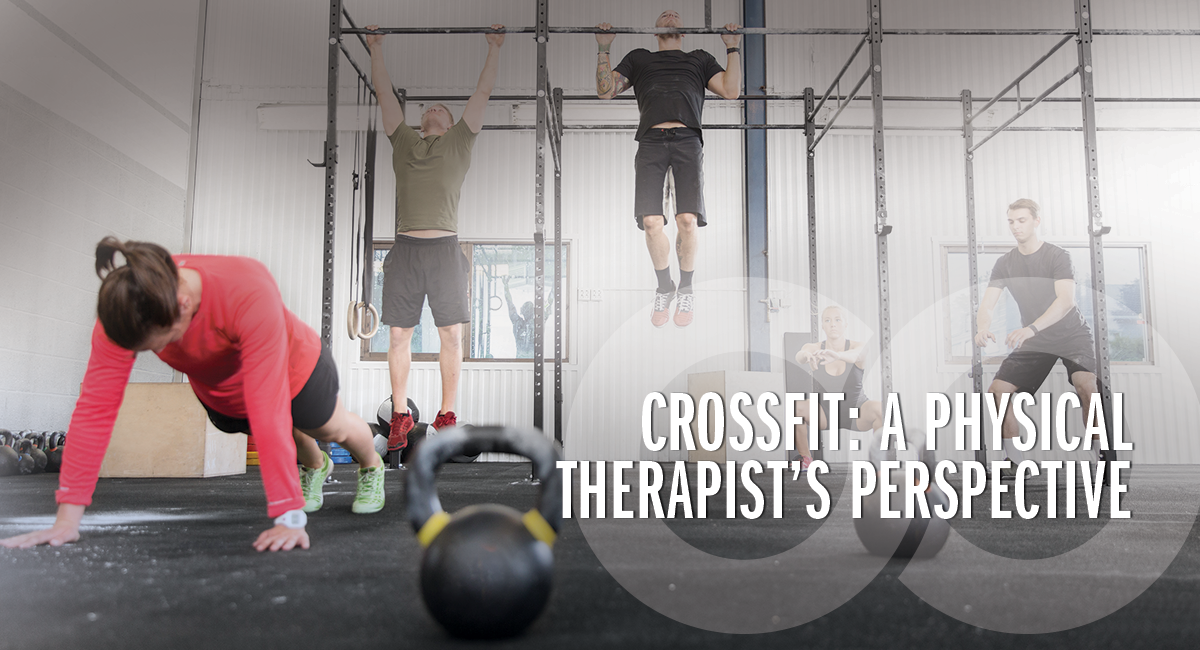Crossfit: A Physical Therapist’s Perspective

Crossfit is a strength and conditioning program that incorporates elements from high intensity interval training, Olympic weightlifting, plyometrics, powerlifting, calisthenics, and strongman type exercises. There are passionate groups of both critics and supporters of Crossfit, which has sparked many conversations on whether it is a good or bad program. The purpose of this post is not to preach Crossfit or anti-Crossfit, but rather discuss Crossfit from a physical therapist’s perspective and let you ultimately decide whether it is the right kind of program for you.
Why is Crossfit so popular?
Crossfit utilizes high intensity interval training, which is a type of exercise strategy alternating periods of short intense anaerobic exercise with less-intense recovery periods. This type of exercise is known to have several health benefits, such as improved cardiovascular endurance, burning more fat than traditional long distance running, and improved metabolism. It also utilizes many multi-joint movements, which has been shown to have a very positive effect on bone density, and challenges our nervous system. These types of workouts can be very effective and fun. They are also constantly changing, which can keep people interested.
Crossfit places a huge emphasis on community. The camaraderie that develops with your exercise group helps to further motivate people to go to the gym and exercise. It’s great for those with a competitive spirit. People’s scores for the Workout of the Day (WOD) are recorded and displayed. One of their mottos is, “the fear of sporting failure is worse than the fear of death.”
Why do people dislike Crossfit?
A big criticism of Crossfit is the frequent injuries. Often, the WOD is geared to getting high weight and high reps, meaning do 100 squats with as much weight as you can. This can often lead to injury when people sacrifice form for numbers. If a person lifts heavy weight many times, they subject their joints to a lot of force and stress. As a physical therapist, I have seen several different types of injuries from individuals participating in Crossfit; such as low back pain, disc herniation, rotator cuff impingement, and meniscus injuries. All of these would have stemmed from poor form, high rep, and high weight.
Another criticism is the lack of training required to become a Crossfit Trainer. Individuals can become certified to train from a 2-day course, and there are no qualifications required to take the course. Once you have been certified, you are free to open up your own affiliate with no quality control enforcement. Many of the workouts involve Olympic lifting, which require significant training to perform correctly. Two days may not be a sufficient amount of time to master the form and technique needed for this kind of difficult lift, let alone teach someone else how to do it. In my experience, it takes years of training and an understanding of kinesiology and functional movement to develop a solid understanding of form and how to build up to high weight bearing exercise.
If done the right way, Olympic lifting is very challenging exercise with big rewards. It’s a move that involves a lot of joints and therefore a lot of muscles. What this means is you work almost your whole body with one move.
On the flip side, the consequences of performing these lifts incorrectly can be significant. For example, if you do a snatch with a weight that is too heavy for you with poor form, you can create an over use injury to your rotator cuff (shoulder impingement), or in a severe case even cause a rotator cuff tear. Jerks done during Olympic lifts can put too much force on the spine, leading to disc herniation.
Now, it is important to clarify that many personal trainer certifications do not require more training than Crossfit. However, with the high level lifting techniques that occur at Crossfit, I believe more required training for the instructors would be beneficial. It should also be noted, that many Crossfit trainers have extensive training and certifications. Some have become certified Crossfit trainers after participating in Crossfit themselves for many years, have a background in another sport, or even have experience in the medical profession. If you decide you would like to pursue Crossfit, look into the credentials and background of your trainer.
The last criticism I would like to address is class size. Depending on where the gym is located and how many members there are, class size can get up to 20 people with only one trainer. A larger class size doesn’t allow for the trainer to monitor proper lifting technique for everyone at once. With this type of training, it is imperative that the individual utilize correct form with the trainer’s help. While not every Crossfit gym has class sizes that big, they do exist. This definitely increases the odds of injury. If you are choosing a Crossfit gym, inquire about class sizes.
The Crossfit strength and conditioning program can hold many benefits for the individual that participates, however there can also be a lot of risk. If you are interested, I suggest first taking several months of private or semi-private classes to learn the difficult lifting techniques and develop the proper neuromuscular connections to perform these lifts. Those who do not regularly participate in similar activities or workout regularly should not attempt this type of exercise without the proper guidance. There is a high risk of injury and all participants need to be aware of the potential of injury and take the appropriate steps to prevent it.